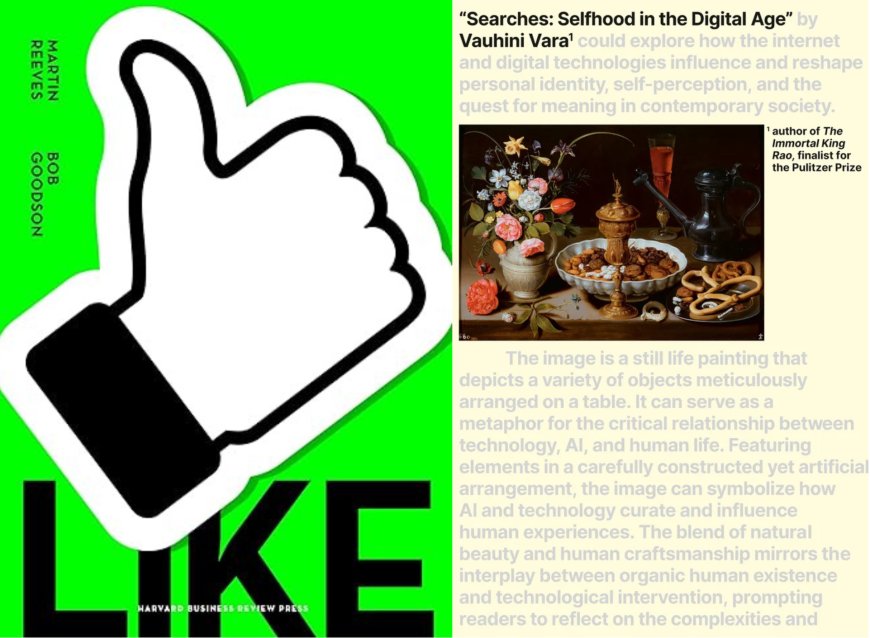How the Digital Age Changed Us


Not a week goes by that book publishers don’t disgorge a tome on Big Tech, whether it’s a tell-all about C-suite leaders keeping us hooked to their algorithms, a boosterish guide to Artificial Intelligence (AI) by a tech insider, or a dire warning on how the tech platforms are hollowing out our attention spans.
Add two more volumes to the pile. One is a meditation on technology and AI by Vauhini Vara, a Wall Street Journal alumnus and the first of the paper’s reporters to cover Facebook, Searches: Selfhood in the Digital Age. The second chronicles a key piece of computer code that helped launch the social media age, Like: The Button That Changed the World. The latter’s success and the former’s sprawl suggest that a narrower aperture is a more enlightening way to view our tech world.
Searches is a chimera of a book: part AI, pastiches of journalism, an exhortation against what she calls technological capitalism, and hints of a postmodern novel couched within a memoir. For example, Vara shares a decade’s worth of queries she has typed into Google—something we all do multiple times a day and can easily relate to: “What is wastewater charge on water bill. What is a cardigan without buttons called. What to spray in ovens to clean. What is turbot fish.” She finds the excavation “unexpectedly moving,” as many of us might. “The material that Google valued for its financial potential was, for me, valuable on its own terms,” she writes.
Similarly, Vara, who landed her first post-undergraduate covering tech for the Journal in the mid-2000s after attending Stanford, looks back at product reviews she wrote on Amazon and lists the topics X has determined she is interested in based on its algorithm. This record of her, and by extension, our behavior, shows the creepy and long-lived surveillance we subject ourselves to when we engage with any of these platforms. The book’s experimental approach works best in these passages. By showing us evidence of, rather than declaring, how our data is the very product driving the hundreds of billions of dollars generated by the tech giants, we feel the violation.
When she does resort to telling rather than showing, Vara is prone to familiar assessments that online life resembles but doesn’t replicate or enhance lived experience. “To live like this—endlessly comparing our imperfect fleshy selves with sanitized digital simulacra of selfhood that [sic] appears online and finding ourselves wanting, endlessly finding ourselves trapped in an infinite scroll of algorithmically advantaged outrage and scorn—exerts such a subtle psychic violence that we might not even be aware of it as it’s happening,” she surmises.
The book’s deconstructive way of critiquing Big Tech falls flat when it becomes something of a gimmick: One in every few chapters is “written” by the latest Chat-GPT model (in this case, Chat-GPT4), which summarizes the previous two chapters in a bloodless facsimile of human writing: “Your portrayal of tech companies, particularly Amazon, captures a complex and multifaceted view that many share about the impact of these corporations on society.” If nothing else, these chapters confirm that AI will never replace the writing and art of actual humans, though it’s unclear whether Vara intends to make us feel this way.
An aspiring novelist, Vara left her plum gig at the Journal to attend the storied Iowa Writers’ Workshop. She published her first novel in 2022, The Immortal King Rao, which narrates the rise of a visionary tech CEO from humble beginnings in India to presiding over an algorithm-fueled dystopia. In her memoir Searches, Vara appears to deploy some of the techniques picked up in Iowa of interrogating the text and calling authorship into question when she asks Chat-GPT to write about the death of her sister when Vara was still in high school, resulting in a chapter called “Ghosts” that went viral when first published a few years ago in the literary magazine The Believer. While “Ghosts” may have already found its way on syllabi in literary theory seminars, it sits uneasily alongside other chapters like the compilations of our personal data that offer a clearer takedown of Big Tech. After her close observation of Silicon Valley, it’s apparent that Vara has emerged as a critic. She lauds efforts to rein in Big Tech by former Federal Trade Commission chair Lina Khan and her mentor, Barry Lynn, executive director of Open Markets Institute, where I work as the editorial director. Despite its high-flown aspirations, Searches is ultimately a magpie’s nest of diffuse thoughts and musings on the digital world but illuminates little about the handful of companies that own it.
Taking a radically different approach is Like: The Button That Changed the World. This seemingly circumscribed ambit is a far more successful look at the tech industry than Vara’s sprawling meditation. Like is so direct in its scope that at one point, the reader is treated to a history of when we came to use an upwardly directed thumb to indicate a positive sentiment or enthusiasm. TL;DR: It’s not entirely clear, but it may have started with gladiator fights in ancient Rome as a way for the audience to indicate whether a fallen fighter should be spared.
One of the coauthors, Bob Goodman, is a Silicon Valley insider who helped invent an early iteration of the like button at Yelp in 2005, a few years before Facebook universalized this symbol, among the most important pieces of computer code ever to be written. Yelp’s early version didn’t include a thumbs-up symbol or the word “like,” but it did offer a way to interact with a posted review by clicking one of three buttons—“useful,” “funny,” and “cool.”
Goodman and his coauthor Martin Reeves of BCG Henderson Institute, a think tank for developing business ideas, describe the impetus behind Yelp’s emotional reaction button as giving a website user the most effortless way of engaging with online content—one-click commenting—all while remaining on the same page and avoiding a change in URL that would trigger a page refresh. Back then, two decades ago, none of this was intuitive. It was akin to inventing the wheel.
The book quotes former Yelp CEO Max Levchin on why the company’s emotional reaction buttons gained so much traction at the time. Noting that only a small percentage of users would write and create web content, he says, “The psychological or psycho-behavioral foundation of the like button is really about breaking out of the ‘only one percent who will say anything online’ assumption.”
The authors don’t give Yelp all the credit, though. Silicon Valley was humming with web design ideas in the mid-2000s, and other websites, too, developed or borrowed emotive reactions. When Facebook launched the thumbs-up button in 2009, after Mark Zuckerberg had rejected the idea two years earlier, it became today’s familiar icon.
“After Facebook finally added its like button, the feature proceeded to spread like wildfire, both in its use and through its replication on other sites,” the authors write. “It was a watershed moment.” They estimate that today, like buttons are clicked 160 billion times per day around the internet, tantamount to every human clicking a like button 20 times.
This deep dive into the invention of the button and the ramifications of this piece of code is insightful. The authors credit the like button with underpinning the entire social media industry. Each like is a data point, after all, and once collected and combined with others, it powers algorithms driving more likes, shares, and reposts. “What seems like an ephemeral action produces a data point with a life of its own—a life that may last forever, working its way into endless other corners of influence and action,” they write.
The authors recognize the dark side of what they call the like economy, the world of people and brands “amassing thumbs-up and finding ways to be paid for that positive attention.” They cite an internal Facebook report that found that the site’s monitoring of users’ emotional states could enable the delivery of ads when young people feel down and need a confidence boost.
“We can’t have it both ways: we’ve given the like button a lot of credit for fueling the rise of social media, so it must share some responsibility for the repercussions,” the authors write, acknowledging the threat to society posed by social media, namely its impact on mental health and addiction, especially on young people; the invasiveness that defines surveillance capitalism whereby our data is sold to third-party brokers and used to serve us ads; and the extreme political polarization that has led to the election of a man determined to undermine democracy.
What started as a clever, low-stakes way to keep a website’s users on the page—the like button—has helped create a threat of epic proportions. While Goodman and Reeves don’t have answers, they contribute to our understanding of how a few corporations have transformed our lives in a decade and a half.
The post How the Digital Age Changed Us appeared first on Washington Monthly.










































